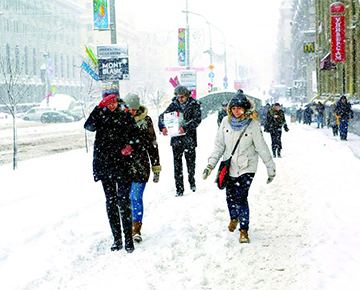The storm Daniella has recently raged across the country. The cyclone, which covered the country with snow, attacked Brest, covered Minsk in snowdrifts and departed towards Vitebsk. It cannot, of course, be compared with hurricane Xavier of March of 2013, being much shorter lived. Though Daniella caused a brief uproar, it did not take us by surprise.

Cyclone Daniella overwhelmed Belarus with snow
Yesterday, 4,770 street cleaners appeared to shovel away the snow in Minsk. Some of them were even out at 4am! In the meantime, many caring drivers put their names on the list of those available to help to pull others out from snowdrifts and assist in delivering people to their destinations where they could get warm and be fed. At the peak of the snowfall, there were known to be more than one hundred people buried in the drift. On the whole, motorists displayed a praiseworthy level of solidarity.
State Traffic Police were also having to work hard under the increased pressure. According to the Department of Motor Vehicles and Traffic Control at the Ministry of Internal Affairs, during the storm the number of minor road traffic accidents virtually doubled. Though the traffic flow was affected, there was no surge in the rate of serious collisions nor were the roads blocked for a long period of time.

Over 300 vehicles were involved in road clearance across the Vitebsk Region
Daniella did cause a considerable number of vehicles to skid on the roads however, and despite advance preparations, 350 snow-removal machines were required on the streets of Minsk to clear the aftermath of the snowstorm during the night shift, said Anatoly Zhamozdik, Gorremavtodor’s Deputy Director General for Municipal Improvements and Maintenance of the Minsk City Executive Committee. During the day, 500 units of special machinery were engaged in snow removal, and over 130 20-tonnne trucks collected snow. 1,113 snow-removal machines had been utilised by midday, as well as manual snow removal by transport workers.
“After hurricane Xavier, several machines from the fleet were re-equipped with sand spreaders and snowploughs. Transport workers themselves removed snow from roundabouts, and park exits where the snow-removal machinery finds it hard to reach,” said the Deputy Director General of Minsktrans, Victor Tozik. “We predicted a similar situation, and we directed more buses, trolley buses and trams to roads that were clear.”

There was also cyclone Emma
Daniella left hundreds of settlements without power and light. The main power cuts occurred in the Minsk, Mogilev and Gomel regions. Repair teams from the utility companies worked round-the-clock to repair the damage in order to restore the electrical supply as soon as possible. In the morning, residents of 207 settlements mostly in rural villages were still without power.
Experts have noted that, when severe weather conditions make access to damaged transmission lines difficult, the number of disconnected houses in the Mogilev and Minsk regions increased. “Long heavy periods of severe weather (snowstorm, sleet, snow with rain), increases of wind with gusts up to 15-18m/s causes power cables to ice up. As a result, there is often damage and transmission lines are cut off,” explained Alexander Malkov, Deputy Head of the Information Technologies Office in Belenergo. Towards the evening, the problems were fixed in more than 500 settlements, with a small number of residents remaining affected.
The most unusual victim of the snowfall was the Dalmatian pelican that winters on the river Drut in the Kirovsk District of the Mogilev Region. Such environmental conditions are a novelty to this exotic bird, and the visitor from the south was rather uncomfortable. We contacted Alexander Vinchevsky, the Executive Director of APB BirdLife Belarus public association. He told us that, “Sometimes birds confuse their routes and fly to the wrong place. The Dalmatian pelican was also seen in Poland where it wintered until January 8th. Generally, European white pelicans visit us more often, while it is the first time in over a hundred years that the Dalmatian variety has been seen in our country.”
By Dmitry Ampilov





















